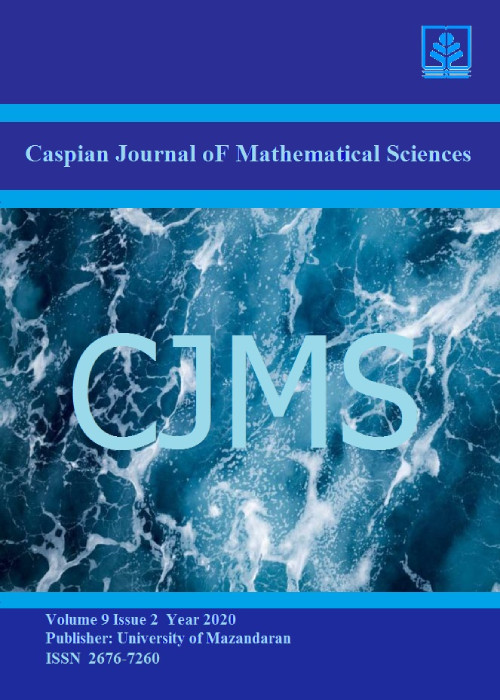فهرست مطالب
Caspian Journal of Mathematical Sciences
Volume:8 Issue: 1, Winter Spring 2019
- تاریخ انتشار: 1397/12/10
- تعداد عناوین: 8
-
Pages 1-9
This paper establishes a direct method for solving variational problems via a set of Radial basis functions (RBFs) with Gauss-Chebyshev collocation centers. The method consist of reducing a variational problem into a mathematical programming problem. The authors use some optimization techniques to solve the reduced problem. Accuracy and stability of the multiquadric, Gaussian and inverse multiquadric RBF is examined and compared by some numerical experiments.
Keywords: Radial basis functions, direct method, variational problems, Gauss, Chebyshev centers -
Pages 10-17
In this paper, the composite order Cayley graph Cay(G, S) is introduced,
where G is a group and S is the set of all composite order elements of
G. Some graph parameters such as diameter, girth, clique number, independencenumber, vertex chromatic number and domination number are calculated for the composite order Cayley graph of some certain groups. Moreover,the planarity of composite order Cayley graph is discussed.Keywords: Cayley graph, Finite groups, Planar graph -
Pages 18-34
We introduce the notion of ideal, prime ideal, lter, fuzzy ideal, fuzzy prime ideal, fuzzy lter of ordered $Gamma$-semiring and study their properties and relations between them. We characterize the prime ideals and lters of ordered $Gamma$-semiring with respect to fuzzy ideals and fuzzy l-
ters respectively.Keywords: Fuzzy prime ideal, fuzzy filter, ordered Γ−semiring -
Pages 35-42
This paper deals with the Legendre wavelet (LW) collocation method for the numerical solution of the radial Schrodinger equation for hydrogen atom. Energy eigenvalues for the hydrogen bound system is derived -13.6 eV. Numerical results of the ground state modes of wave function for the hydrogen R(r) or the electron probability density function, has been presented. The numerical results have been compared to the other existing method and exact solution.
Keywords: Schr¨odinger equation, Hydrogen atom, Legendre wavelet, Collocation metho -
Pages 43-50
In this paper, we prove the existence of an open interval $mathrm{]}{lambda }^{mathrm{'}},{lambda }^{mathrm{''}}mathrm{[}$ for each $lambda $ of which a class of two-point boundary value equations depending on $lambda $ admits at least three solutions. Our main tool is a three critical points theorem of Averna and Bonanno.
Keywords: Three solutions, critical points, two-point boundaryvalue system -
Pages 51-57
In this paper, we nd the coefficient bounds by using symmetric Toeplitz determinants for the functions belonging to the subclass R(q).
Keywords: Univalent functions, Toeplitz matrices, q-derivativeoperator -
Pages 58-73
In this paper, Firstly, we introduce a new version of Bishop frame using a common vector field as normal vector field of a regular curve and call this frame as type-3 Bishop frame. Geometric visualization for both Frenet frame and type-3 Bishop frame are plotted. Secondly, time evolution equation for type-3 Bishop frame and type three bishop curvatures are obtained and we plotted the evolving curve via the numerical integration of type-3 Bishop Serret Frenet equations. Finally, surfaces generated by evolving a regular space curve in $mathbb{R}^3$ as it evolves over time with arbitrary velocities attached to type-3 Bishop frame are obtained. We plotted these surfaces via numerical integration of Gauss-Weingarten equations.
Keywords: Type-3 Bishop frame, Serret-Frenet equations, Timeevolution equation, Gauss-Weingarten equations -
Pages 74-83
In this paper, we introduce the concept of S_{beta} -connectedness which lies between semi-connectedness and connectedness. We also characterize this type of connectedness and discuss its relationships with the various types of connectedness from the literature. We further consider the components of this type of connectedness and its properties.
Keywords: Semi-connected, β-connected, Preconnected, Hyperconnected, Sβ-connected


